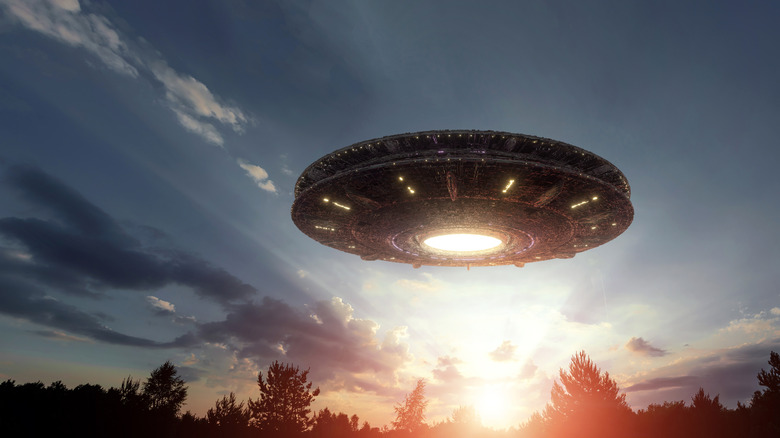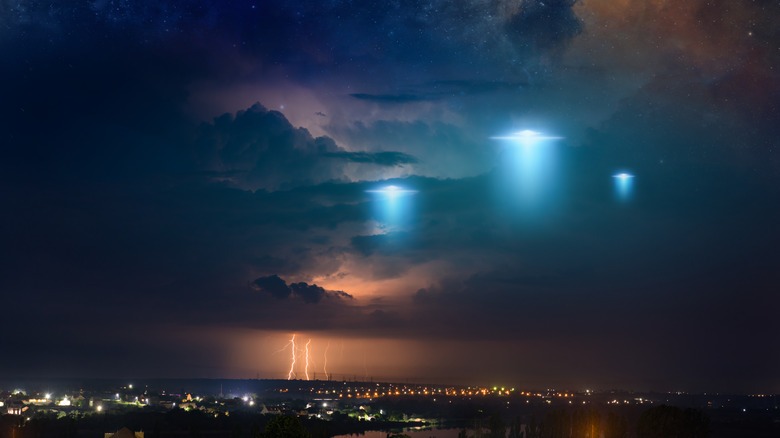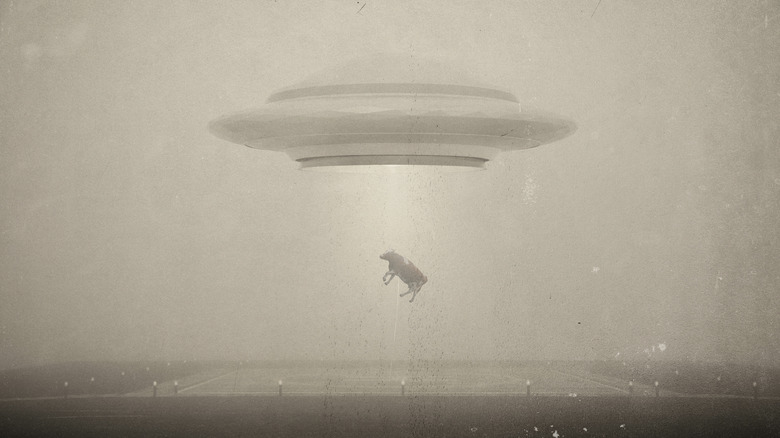UFOs: The Biggest Things In The US Government's Latest Report
For decades, one of the conspiracies surrounding UFOs is that the federal government in the United States knows more than it's letting on. Such a conspiracy could take on many forms. For example, some may be content to believe that the government has been tight-lipped about them simply because it doesn't consider this matter real or important. Or maybe the government knows that alien spacecraft are real and have visited us but doesn't want to invoke a worldwide panic. An extreme example of these conspiracies is that the government has been working with aliens directly or reverse engineering alien spacecraft at Area 51.
While it cannot be confirmed whether or not the government is currently alien housing craft in the Nevada desert, we can say with certainty that the feds have been considerably less tight-lipped about UFOs. After decades of silence on the matter, recent years have seen the Department of Defense declassify documents related to UFO sightings. And in January 2023, the Office of the Director of National Intelligence issued a U.S. Department of National Intelligence (DNI) report that plainly reveals some truths about UFOs. And while there's nothing in there that's Earth-shattering — no alien autopsies or confirmation that alien crafts have visited us — there is confirmation that sightings of unidentified flying objects (they go by a new name now; more on that in a moment) is common and on the rise.
They're not UFOs anymore, they're UAPs
The government is known for its copious use of acronyms. Whether it's the name of an agency, place, or even title, acronyms are everywhere in the government world. Emileigh Barnes of the U.S. General Services Administration (GSA) wrote, "It was faster to type ETB, AFSPD, ATF than the full, 19-word name. And my colleagues knew what it stood for. But to an outsider, that string of letters looks completely devoid of meaning." And just like how they're created, these acronyms can be changed.
The phrase "UFO" is one of those acronyms, like scuba or radar, that has colloquially become a word in its own right, replacing the series of words — in this case unidentified flying object — that it was meant to represent. It's too bad that, as far as the government is concerned, they're not called UFOs anymore. The title of the 2022 Report on Unidentified Aerial Phenomena makes it clear that "unidentified flying object" has been replaced by a new phrase. A 2021 article in Smithsonian Magazine notes the change in vernacular but doesn't explain how or why, or even when the change was made, only that the term "UFO" dates back to the 1950s.
The government admits UAPS exist
Do note that when we say that the government is now admitting that what was once called "UFOs" and are now "UAPs" exist, we are not saying that alien spacecraft exist. What we mean is that the government is admitting that there have been cases when an object was spotted in the sky, and no one knows what it was. It's not that they are alien spacecraft or unknown craft produced by our nation's enemies, as pop culture would suggest. Just that, whatever they were, we don't know what they were.
Regardless, that the government is stating that people and instruments have seen or detected mysterious craft is huge. For decades, the government's response was to simply not talk about it. "The Pentagon's public attitude toward sightings of UFOs – now rebranded as UAPs – has shifted dramatically in recent years," IGN notes. The outlet points to legislative action in 2021 that requires that Congress receive unclassified reports from the All-Domain Anomaly Research Office (AARO) about these instances on a yearly basis.
UAP Sightings Are Increasing
Along with the government's admission to the existence of UAPs is that there is an increase in the number of such sightings (at least, those that the government has decided to take seriously). U.S. News & World Report suggests that the fact that the government is being (somewhat) more open with the general public about these matters may be at least partially responsible for this increase. "[The Office of the Director of National Intelligence] applauded the sharp increase in pilots' reporting – a sign of a shift away from the stigma that discouraged aviators from acknowledging mysterious aerial encounters."
That leaves unanswered the question of whether or not there are more unidentified craft poking about or if there are more reports now because of the increased instances of military pilots spotting them (per U.S. News & World Report). Nevertheless, the increase is sharp. The 2022 report, for example, dealt with 144 such sightings, while the 2023 report covers 247.
They're Not All (Necessarily) Unexplained
Just because an incident involving a potential UAP has been labeled as such by the government and has been included in its report does not necessarily mean that the report has concluded that the craft is something we don't know about. As IGN explains, the report notes that a significant number of supposed UAP sightings were actually quite mundane. For example, 163 reports of UAPs were probably just weather balloons, a couple of dozen were probably drones, and a small handful were likely just trash, such as plastic bags.
Still, that leaves 171 that have left authorities scratching their heads. A few of those demonstrated "unusual flight characteristics or performance capabilities, and require further analysis." Again, this is not to say that anyone in Washington D.C. is confirming that alien and/or foreign spacecraft that can seemingly defy what is known about flight and the laws of physics are poking about in our atmosphere, but that what has been observed doesn't fit into an easy and ready explanation.
Lawmakers Aren't Satisfied
As U.S. News & World Report notes, it was Congress that convinced government agencies to open up about UAPs and UAP sightings and demanded annual reports. However, the publication notes that not all lawmakers are satisfied with the crumbs that the Office of the Director of National Intelligence is dropping in front of them. "We are making important progress in our ongoing efforts to understand these activities and what threat they may pose to America's national security," said Senator Marco Rubio (above), vice chairman of the Senate Intelligence Committee.
Rubio and other lawmakers also criticized the report for giving so few details. "More needs to be done across the Defense Department and Intelligence Community to utilize existing sensors to collect and analyze more data on UAPs. I am committed to ensuring we get to the truth for the American people," said Rubio. Those words were echoed by Representative Mike Gallagher of Wisconsin, who noted that "we must figure out what our military aviators are observing in our airspace."
The stakes are high, not necessarily because we may be on the cusp of an alien invasion or even because our enemies may be outfoxing us in space and the skies. Rather, it behooves our military (and, to a lesser extent, our civilian aerospace infrastructure) for pilots to know exactly what they are sharing the skies with, even if those things are mundane things such as drones or balloons or trash.





